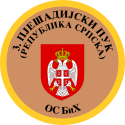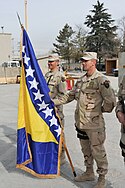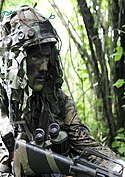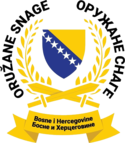Bosnisch-Herzegowinische Streitkräfte
| |||
 | |||
| Führung | |||
|---|---|---|---|
| Oberbefehlshaber: | Vorsitzende des Staatspräsidiums: Milorad Dodik, Željko Komšić, Šefik Džaferović | ||
| Verteidigungsminister: | Sifet Podžić | ||
| Militärischer Befehlshaber: | Generalleutnant Senad Mašović | ||
| Militärische Stärke | |||
| Aktive Soldaten: | 9200 | ||
| Reservisten: | 4600 | ||
| Wehrpflicht: | 2006 abgeschafft | ||
| Wehrtauglichkeitsalter: | 18 Jahre | ||
| Haushalt | |||
| Militärbudget: | 150 Mio. Euro | ||
| Anteil am Bruttoinlandsprodukt: | 0,41 % (2018) | ||
| Geschichte | |||
| Gründung: | 1. Dezember 2006 | ||
Die Streitkräfte von Bosnien und Herzegowina (bosnisch/kroatisch/serbisch Oružane snage Bosne i Hercegovine/Оружане снаге Босне и Херцеговине), kurz OS BiH/ОС БиХ, wurden 2006 aus der Armee der Föderation Bosnien und Herzegowinas (VFBiH) und der Armee der Republika Srpska (VRS) gebildet. Die Streitkräfte von Bosnien und Herzegowina bestehen aus Heeresverbänden und Luftstreitkräften, wobei die Luftstreitkräfte keine eigene Teilstreitkraft bilden. Marineverbände bestehen nicht. Zu den Streitkräften gehören etwa 9200 aktive Soldaten, 4600 Reservisten und 1000 zivile Angestellte. Die allgemeine Wehrpflicht wurde am 1. Januar 2006 aufgehoben.
Angestrebt wird die Integration der Streitkräfte in europäische und euroatlantische Strukturen und die Beteiligung an UN-Einsätzen. 2006 trat Bosnien und Herzegowina der NATO-„Partnerschaft für den Frieden“ bei. Im Oktober 2010 wurde ein aus 45 Mitgliedern bestehendes militärisches Kontingent zur Unterstützung der International Security Assistance Force (ISAF) nach Afghanistan entsandt.
Geschichte
Die bosnisch-herzegowinischen Streitkräfte gehen auf die drei im Bosnienkrieg gegeneinander kämpfenden Armeen zurück, nämlich der Armee der Republik Bosnien und Herzegowina (ARBiH), dem Kroatischen Verteidigungsrat (HVO) und der Armee der Republika Srpska (VRS). Nach dem Bosnienkrieg lag die Verteidigungspolitik bis Ende 2004 bei den beiden neu gebildeten Entitäten Föderation Bosnien und Herzegowina und Republika Srpska die ihre eigenen Streitkräfte unterhielten, aus denen 2006 die bosnisch-herzegowinischen Streitkräfte gebildet wurden. Diese unterstehen dem Staatspräsidium und dem bereits 2004 geschaffenen Ministerium für Landesverteidigung.
Gliederung
Das Heer gliedert sich in die drei mechanisierten Infanterieregimenter 4., 5. und 6. Infanterie-Regiment, eine Heeresfliegerbrigade und eine Unterstützungsbrigade, welche dem Operationskommando unterstehen. Dem Ausbildungskommando unterstehen die Ausbildungs- und Logistikeinheit.
Neben den formal integrierten operativen Strukturen bestehen jeweils ein kroatisches, bosniakisches und serbisches Regiment (1., 2. und 3. Infanterie-Regiment), welche die Traditionen der drei historischen Streitkräfte HVO, ARBiH und VRS fortführen sollen.
Ausrüstung
An Ausrüstung ist vorhanden:
- Panzer:
- Geschütze:
- 26 105 mm L-118 „Light Gun“
- 9 105 mm M-2A1
- 6 105 mm M-56
- 81 122 mm D-30
- 2 152 mm M84
- 49 155 mm M114A2
- 12 122 mm 2S1
- Raketenwerfer:
- 9 107 mm Typ 63
- 4 122 mm BM-21
- 8 128 mm M-91
- 8 9K52 Luna-M
Luftfahrzeuge
Die Heeresfliegerbrigade setzt folgende Luftfahrzeuge ein:[1]
- 6× Mi-8
- 8× SA 342L Partizan
- 5× UH-1H
Galerie
Militärpolizisten in MARPAT-Uniformen auf dem Truppenübungsplatz Hohenfels in der Oberpfalz 2014
Angehörige des ISAF-Kontingentes beim Appell mit ihrer Nationalflagge 2015
Soldat des 1. Infanterie-Regiments (Traditionsregiment HVO) beim Manöver auf dem Truppenübungsplatz „Eugen Kvaternik“ bei Slunj 2012
Soldat in Tarnkleidung
Symbole (Auswahl)
Hoheitszeichen
Ärmelabzeichen der Traditionsregimenter
1. Infanterie-Regiment, in Tradition des Kroatischen Verteidigungsrates (HVO)
2. Infanterie-Regiment, in Tradition der Armee der Republik Bosnien und Herzegowina (ARBiH)
3. Infanterie-Regiment, in Tradition der Armee der Republika Srpska (VRS)
Siehe auch
- Dienstgrade der bosnisch-herzegowinischen Streitkräfte
Weblinks
- Internetpräsenz des bosnisch-herzegowinischen Verteidigungsministeriums. Abgerufen am 20. September 2015.
- Länderinformation des österreichischen Verteidigungsministeriums
Einzelnachweise
- ↑ World Air Forces 2021. flightglobal.com, abgerufen am 23. März 2021.
Auf dieser Seite verwendete Medien
Грб III пјешадијског пука (Република Српска) ОС БиХ
A member of the Bosnian army military police provides security Sept. 3, 2009, during the Combined Endeavor 2009 opening ceremony at Kozara Barracks, Bosnia-Herzegovina. Combined Endeavor is a Headquarters U.S. European Command-sponsored communications and information systems interoperability test between and among Partnership for Peace and NATO nations. (U.S. Air Force photo by Tech. Sgt. Prentice L. Colter/Released)
ISAF Bosnian troops pose with their national flag.
Autor/Urheber: Diese W3C-unbestimmte Vektorgrafik wurde mit Inkscape erstellt ., Lizenz: CC BY-SA 3.0
Patch of 1. Infantry ( Guard ) Regiment
ISAF Bosnian troops line up, awaiting for the general march of the Lt. Anto Jeleč.
Autor/Urheber: U.S. Army Europe Images from Heidelberg, Germany, Lizenz: CC BY 2.0
A soldier with the Armed Forces of Bosnia and Herzegovina, waits to spring an ambush on enemy forces while on an ambush Situational Training Exercise during Immediate Response 2012 held at the Slunj Training Area 1 June. Immediate Response 2012 is a multinational tactical field training exercise that will involve more than 700 personnel primarily from the U.S. Army Europe’s 2nd Calvary Regiment and Croatian armed forces, with contingents from Albania, Bosnia-Herzegovina, Montenegro and Slovenia. Macedonia and Serbia will send observers to the exercise. The exercise is a part of U.S. European Command's joint training and exercise program designed to enhance joint and combined interoperability between the U.S. Army, U.S. Air Force and partner nations, and will help prepare participants to operate successfully in a joint, multinational, interagency, integrated environment. (U.S. Army Europe photo by Staff Sgt. Joel Salgado/Released)
Twin Bosnian soldiers, both military police officers, pose for a photo during Saber Junction 2014 at the Hohenfels Training Area in Hohenfels, Germany, Sept. 2, 2014. The brothers have served together for six years. Saber Junction is a U.S. Army Europe-led exercise designed to prepare U.S., NATO and international partner forces for unified land operations.
Autor/Urheber: Noclador, Lizenz: CC BY-SA 3.0
Armed Forces Bosnia Herzegovina - Operational Command Structure
Cropped version of the official amblem/coat of arms of the Armed Forces of Bosnia and Herzegovina.
Autor/Urheber: Hazbulator, Lizenz: CC BY-SA 4.0
The emblem of the 2nd Infantry Regiment (Bosniak) of the Armed Forces of Bosnia and Herzegovina.
Autor/Urheber: U.S. Army Europe Images from Heidelberg, Germany, Lizenz: CC BY 2.0
A machine gunner with the Armed Forces of Bosnia and Herzegovina, lays down suppressing fire while on an ambush Situational Training Exercise during Immediate Response 2012 held at the Slunj Training Area 1 June. Immediate Response 2012 is a multinational tactical field training exercise that will involve more than 700 personnel primarily from the U.S. Army Europe’s 2nd Calvary Regiment and Croatian armed forces, with contingents from Albania, Bosnia-Herzegovina, Montenegro and Slovenia. Macedonia and Serbia will send observers to the exercise. The exercise is a part of U.S. European Command's joint training and exercise program designed to enhance joint and combined interoperability between the U.S. Army, U.S. Air Force and partner nations, and will help prepare participants to operate successfully in a joint, multinational, interagency, integrated environment. (U.S. Army Europe photo by Staff Sgt. Joel Salgado/Released)
Autor/Urheber: U.S. Army Europe Images from Heidelberg, Germany, Lizenz: CC BY 2.0
A soldier with the Armed Forces of Bosnia and Herzegovina, conducts security while on an ambush Situational Training Exercise during Immediate Response 2012 held at the Slunj Training Area 1 June. Immediate Response 2012 is a multinational tactical field training exercise that will involve more than 700 personnel primarily from the U.S. Army Europe’s 2nd Calvary Regiment and Croatian armed forces, with contingents from Albania, Bosnia-Herzegovina, Montenegro and Slovenia. Macedonia and Serbia will send observers to the exercise. The exercise is a part of U.S. European Command's joint training and exercise program designed to enhance joint and combined interoperability between the U.S. Army, U.S. Air Force and partner nations, and will help prepare participants to operate successfully in a joint, multinational, interagency, integrated environment. (U.S. Army Europe photo by Staff Sgt. Joel Salgado/Released)


























